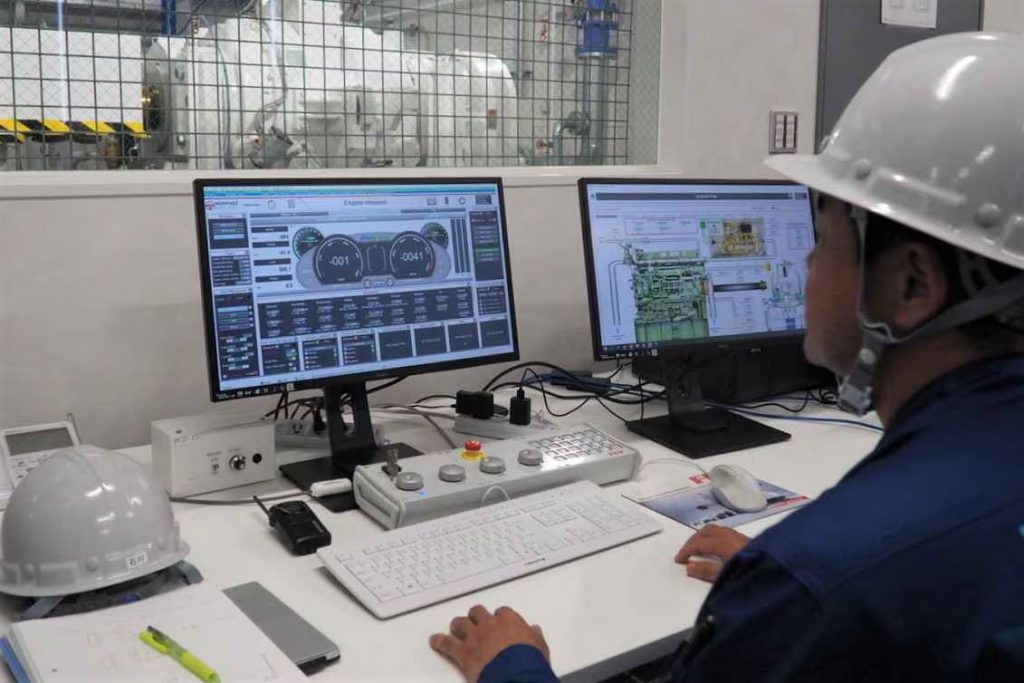このページを 日本語 で読む
A groundbreaking project aimed at achieving a carbon-neutral society has launched in Hiroshima. Hydrogen-fueled ships, recognized as a promising next-generation energy source, are gaining widespread attention.
In September, the Hydrogen Engine R&D Center was established in a shipyard in Fukuyama City, Hiroshima Prefecture, as a dedicated hub for research and development. The center’s ambitious goal is to build and test the world’s first zero-emission ship, powered by a hydrogen engine that produces no carbon dioxide, by 2026.
Japan’s shipbuilding industry, once a global leader, now faces steep competition from government-backed Chinese and South Korean firms.
End-to-End Development
This center, part of The Nippon Foundation’s Zero-Emission Ship Project, is equipped with performance testing facilities and a control analysis room. It supports all stages of development, from hydrogen engine research to ship storage and fueling.
It is the first facility worldwide located within a shipyard to manage these processes end-to-end. A dedicated hydrogen station for ships is planned on adjacent waterfront land, with completion targeted for January 2025. Additional plans include a mobile, floating hydrogen station.
The center is operated by Tsuneishi Group and Japan Hydro, both based in Fukuyama City. Tsuneishi Group focuses on shipbuilding and maritime transport. Japan Hydro is a joint venture backed by CMB Tech, the research and development arm of Belgium’s shipping giant CMB. The companies hope that this project will also serve as a powerful catalyst for Japan's shipbuilding industry.
Japan Hydro successfully launched the Hydro Bingo, the world’s first passenger ship with a diesel-hydrogen co-combustion engine, achieving a 30–50% reduction in CO2 emissions. The company is now advancing in phases to develop a fully zero-emission ship.
Designed as an open lab, the center welcomes institutions and companies working on hydrogen engine technology, aspiring to become Japan’s leading R&D hub. Beyond marine applications, the center envisions extending hydrogen engine technology to large trucks, heavy equipment, and trains.
Deadline Approaching
Hydrogen is a clean energy source that doesn’t emit carbon dioxide when burned. Unlike renewable sources like wind or solar, hydrogen can be produced consistently, regardless of weather conditions, offering a significant advantage.
However, high production costs relative to fossil fuels, along with the need for specialized equipment to compress or liquefy hydrogen for storage and transport, have hindered its widespread adoption.
“Hydrogen is better suited to local production and use rather than long-distance transport. So domestic production will eventually increase, bringing down procurement costs,” explains Yu Aonuma, CEO and Executive Officer of Japan Hydro.
“I want to accelerate the practical use of hydrogen engines. It’s not a question of which comes first, the chicken or the egg - if hydrogen-powered ships become more common, they could spark demand for hydrogen fuel,” he adds enthusiastically.
At the same time, Aonuma acknowledges, “The timeline is tight.”
Japan aims to achieve net-zero greenhouse gas emissions by 2050. The International Maritime Organization (IMO) has set a similar target, focusing on international shipping, which transports about 90% of global trade.
However, while ships have a long service life of 15 to 30 years, building just one ship can take several years. With limited annual ship production capacity, transitioning to hydrogen-powered vessels will be a lengthy process. Japan’s Ministry of Land, Infrastructure, Transport, and Tourism warns that “if zero-emission ships aren’t being built by 2030, it will be too late.”
Aonuma underscores the urgency, saying, “We’re nearly out of time.”
Hydrogen as a Champion for Japan's Ships
The maritime industry is making strides in decarbonization, and hydrogen is gaining attention as a promising energy source. Meanwhile, competition in zero-emission ship development is intensifying, especially with China and South Korea in the race.
Mitsuyuki Unno, Executive Director of The Nippon Foundation, stresses the importance of collaboration, stating, “We want to drive development forward by involving different fields.”
Aonuma echoes this vision: “Our goal is to accelerate the development and adoption of hydrogen engines through collaborations with academic institutions and domestic manufacturers. We aim to carry the maritime and shipbuilding industries into the next generation with an ‘all-Japan’ effort to stay competitive.”
Japan leads the world in hydrogen-related patent applications. Could zero-emission ships be the key to revitalizing Japan’s shipbuilding industry?
The race isn’t only against international rivals - it’s also a race against time.
RELATED
- Hydrogen-Powered Golf Carts: Yamaha Motor Seizes Opportunity in US Market
- Hokkaido Town Pioneers Next-Gen Biofuel and Power Generation from Livestock Waste
(Read the original article in Japanese.)
Author: Motohiro Wada, The Sankei Shimbun
このページを 日本語 で読む
